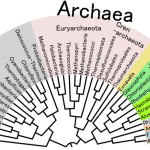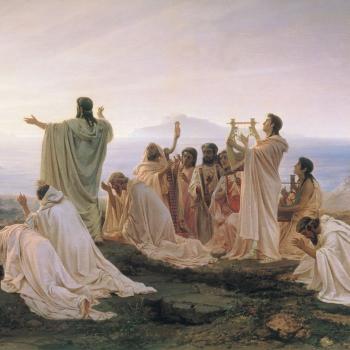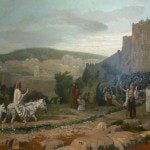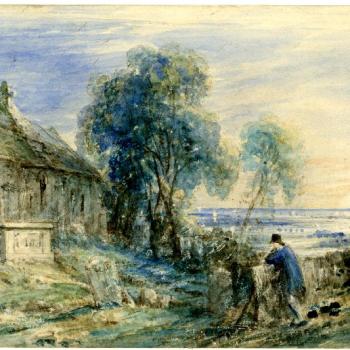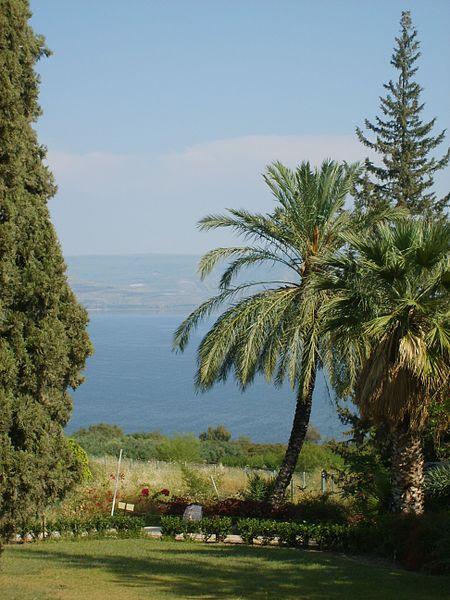
(Wikimedia Commons public domain photo)
I should have said something earlier about the physical setting of the Matthew’s account of the Sermon on the Mount, about its location:
“And seeing the multitudes, he went up into a mountain: and when he was set, his disciples came unto him: And he opened his mouth, and taught them.” (Matthew 5:1-2)
First of all, readers should rid their minds in this context of anything even remotely resembling the mountains of the American West, let alone the Canadian Rockies or the Swiss Alps. No such mountains exist in the relevant area.
Secondly, it might be that the Savior simply climbed up a hill for reasons of acoustics, because he wanted his voice to carry to his audience. In fact, I’m confident that considerations of sound played a role. But there may also be significance in the fact that Jesus spoke downward from a “mountain.”
For one thing, we should perhaps be thinking of the temple associations of “the mountain of the Lord” or “the mountain of the Lord’s house.”
For another, there may be an implicit statement here of Jesus’ divinity and of his unique authority. Moses had ascended Mount Sinai to receive the law from the Lord. Centuries later, Jesus ascended a “mountain” and, from it, handed a new “law” down from on high. Functionally, he seems to have assumed the role of the God of Moses—something that will not altogether surprise most Latter-day Saints.
Please notice, in this regard, the several places in Matthew 5 alone where Jesus says something along the lines of “Ye have heard that it was said of them of old time . . . But I say unto you” (e.g., at verses 21-22, 27-28, 31-32, 33-34, 38-39, 43-44). Jesus doesn’t cite previous authorities. He doesn’t make an argument. He simply declares. The final two verses of Matthew 7, at the very conclusion of the Sermon on the Mount, are worth recalling here:
“And it came to pass, when Jesus had ended these sayings, the people were astonished at his doctrine: For he taught them as one having authority, and not as the scribes.” (Matthew 7:28-29)
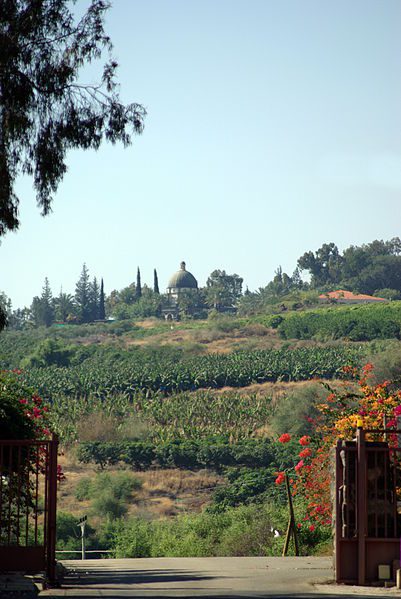
(Wikimedia Commons public domain photograph)
“Blessed are they which do hunger and thirst after righteousness,” says the King James Version at Matthew 5:6, “for they shall be filled.”
This beatitude uses some of the most familiar, the most common, of human experiences—hunger and eating, thirst and drinking, followed by satiety—to make an abstract point. The technique is typical of Jesus’ approach to teaching and is perhaps best represented by his parables. Shepherds, sheep, farmers, lost coins, field laborers, stone carving—these and other everyday features of first-century Palestinian life recur throughout his ministry, all in the service of spiritual and ethical lessons. He could simply have issued declarations about faith, devotion, kindness, and the like. Instead, he clothed what he wanted to say in simple but memorable stories that have figured in stained glass windows and sermons and Sunday school lessons and even clichés for two millennia, conveying his message in ways that both attract scholarly commentary and stimulate conversations among rural illiterates in the most remote areas of the globe.
Mention of “hunger and thirst” suggests much more than casual interest. It implies dedication. Devotion. Valiancy. Urgency. I’m reminded of a tale about the great Greek philosopher Socrates that I read or heard many years ago. I can’t recall the source—and, since I’m in the backseat of a car right now, with neither internet nor reference library, I think that I’ll just press on. I’ll find the source later. And it doesn’t really matter much, for my purposes at the moment, whether the story is historically accurate or authentically ancient.
It seems that Socrates used to spend a fair amount of time in and around Piraeus, which was the seaport of the relatively nearby but landlocked city-state of Athens. Socrates was reputedly quite homely, but he was also unusually strong. He had served as a soldier in one of the Athenian wars. One day, supposedly, a man approached him, asking to become one of his disciples. Socrates responded by inviting the somewhat puzzled man to walk with him out into the surf. Once they had reached an area that was deep enough, Socrates suddenly seized the man and pushed his head under the surface of the water. The man flailed and struggled, but Socrates held him down for a fairly long time. Finally, he released his prisoner; the poor man came to the surface gasping for oxygen. “When you are as desperate for wisdom as you were for air,” Socrates told him, “you will be ready to be my disciple.”
I smile to think what the response of a modern collegiate dean of student life might be to Socrates’ reputed teaching method. Fortunately, as both Socrates and the would-be disciple are both long dead, there will probably be no complaint to the university ombudsman and no negative reviews on “Rate My Professor.”
But some sort of urgent hunger and thirst for righteousness is surely required. Believers in the Restoration understand that our eternal goal isn’t simply an unending, pain-free but rather pointless existence in a beautiful garden, or an eternity spent sitting on a fluffy cumulus cloud while plucking a harp. (I once asked a friend who holds a master’s degree in harp performance and who regularly appears on television while pursuing her art whether it doesn’t bother her that musical deadbeats such as I will, if the divine judgment goes our way, instantly become superb harpists at the moment of our deaths.)
Rather, our destiny, if we follow the covenant path, is to become like our Father, to be deified, to be (in some non-trivial and real sense) Gods. Restored in the nineteenth century, this doctrine of human divinization finds ancient echoes in threads of early Christianity that survive not only in the Christian East but, in some regards, in the Catholic and even Protestant traditions of the West.
Think of the magnitude of the goal! Obviously, much more is required of us than merely a vague sentiment that it would be nice to be nice someday.
“It would seem that Our Lord finds our desires not too strong, but too weak. We are half-hearted creatures, fooling about with drink and sex and ambition when infinite joy is offered us, like an ignorant child who wants to go on making mud pies in a slum because he cannot imagine what is meant by the offer of a holiday at the sea. We are far too easily pleased.” (C. S. Lewis, The Weight of Glory, and Other Addresses)
Finally (enough for today!), the additional phrase in the Book of Mormon’s equivalent passage to Matthew 5:6 is, I think, very much worth noting:
“Blessed are all they who do hunger and thirst after righteousness, for they shall be filled with the Holy Ghost.” (3 Nephi 12:6)


